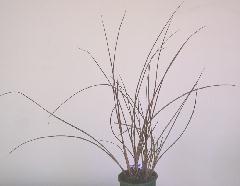
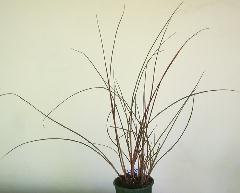
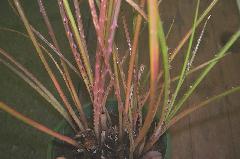
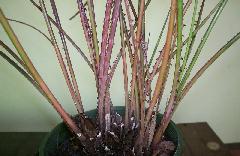
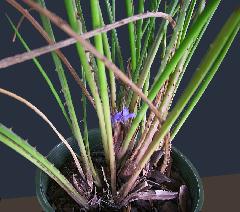
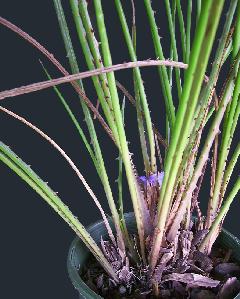
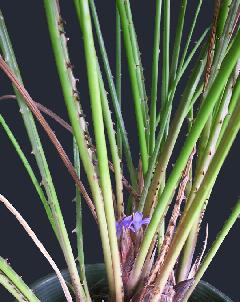
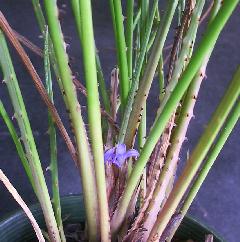
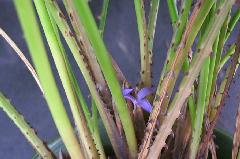
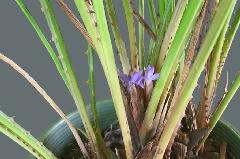
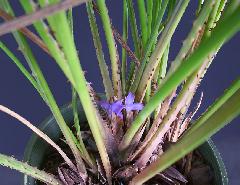
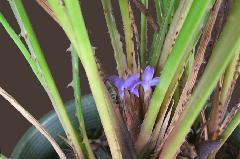
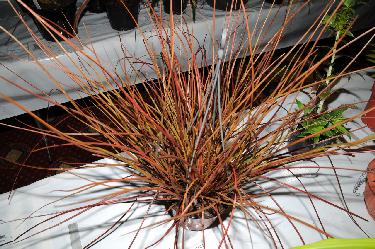
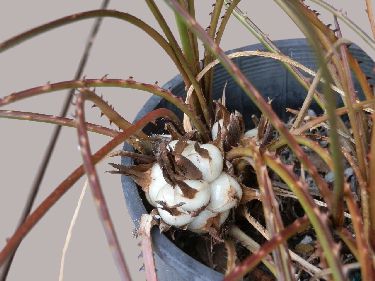
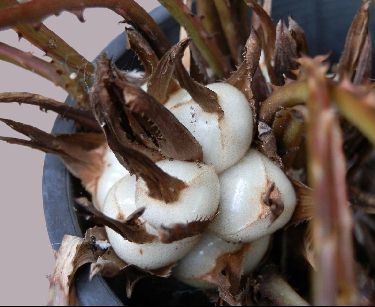
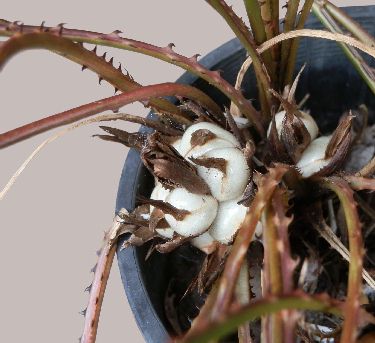
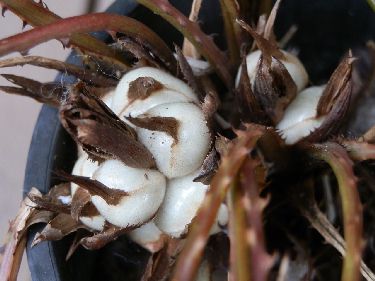
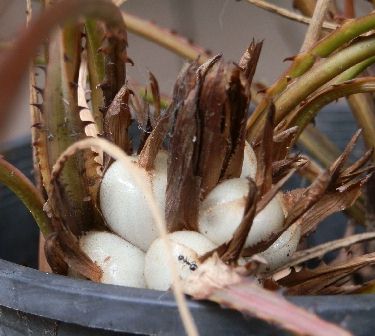
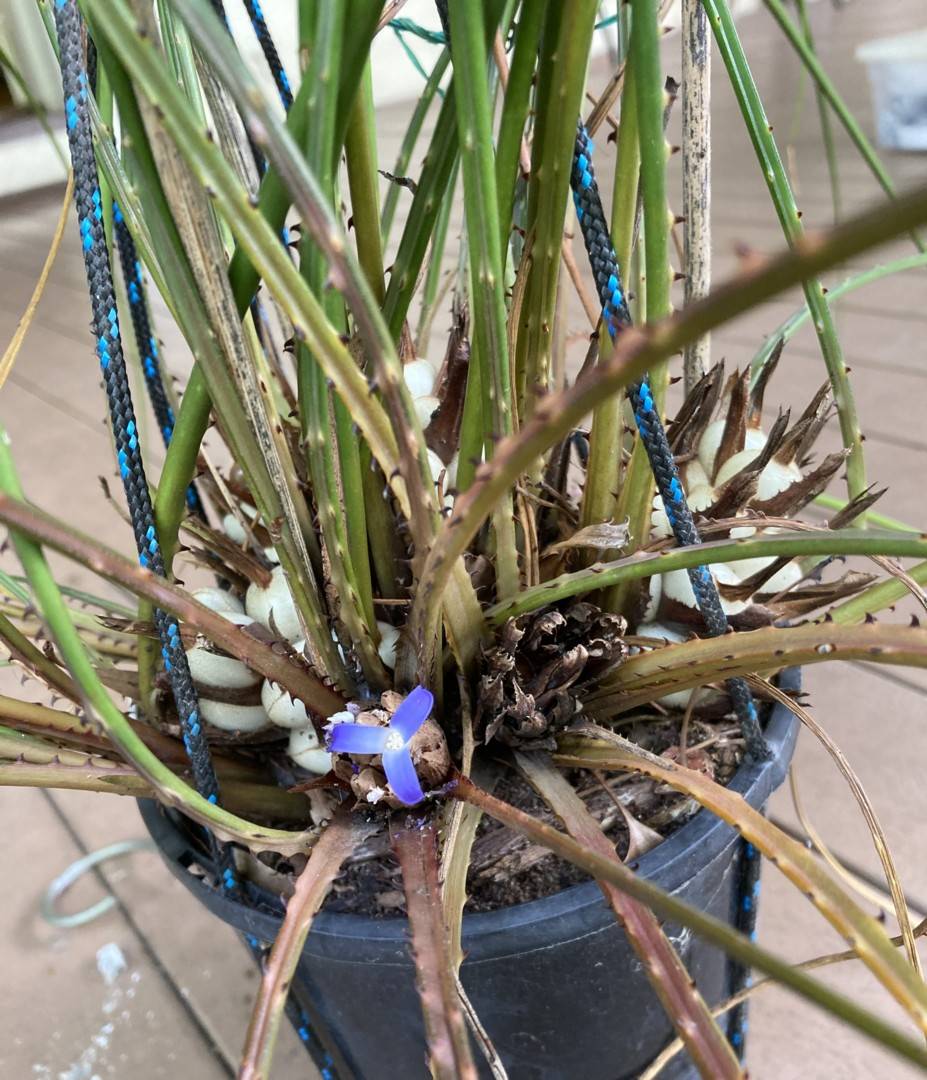
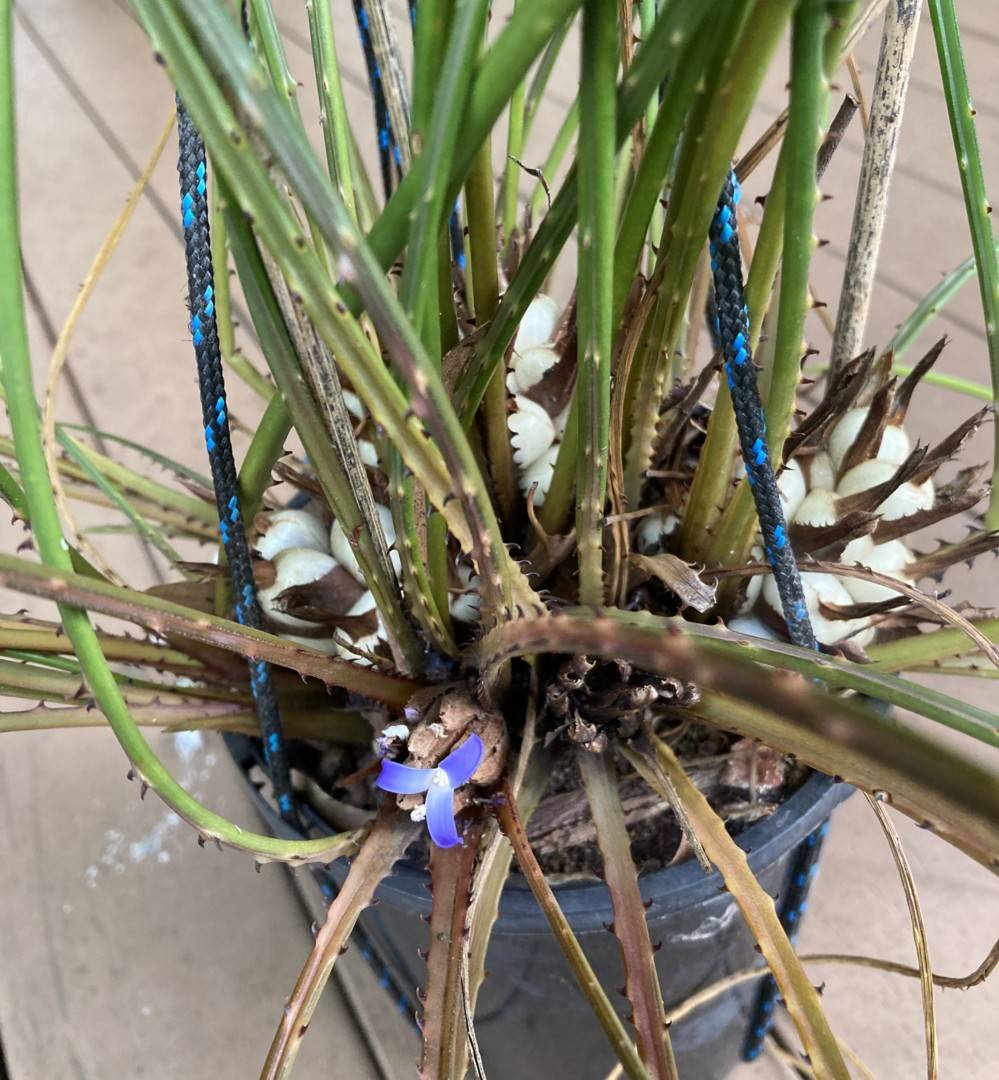
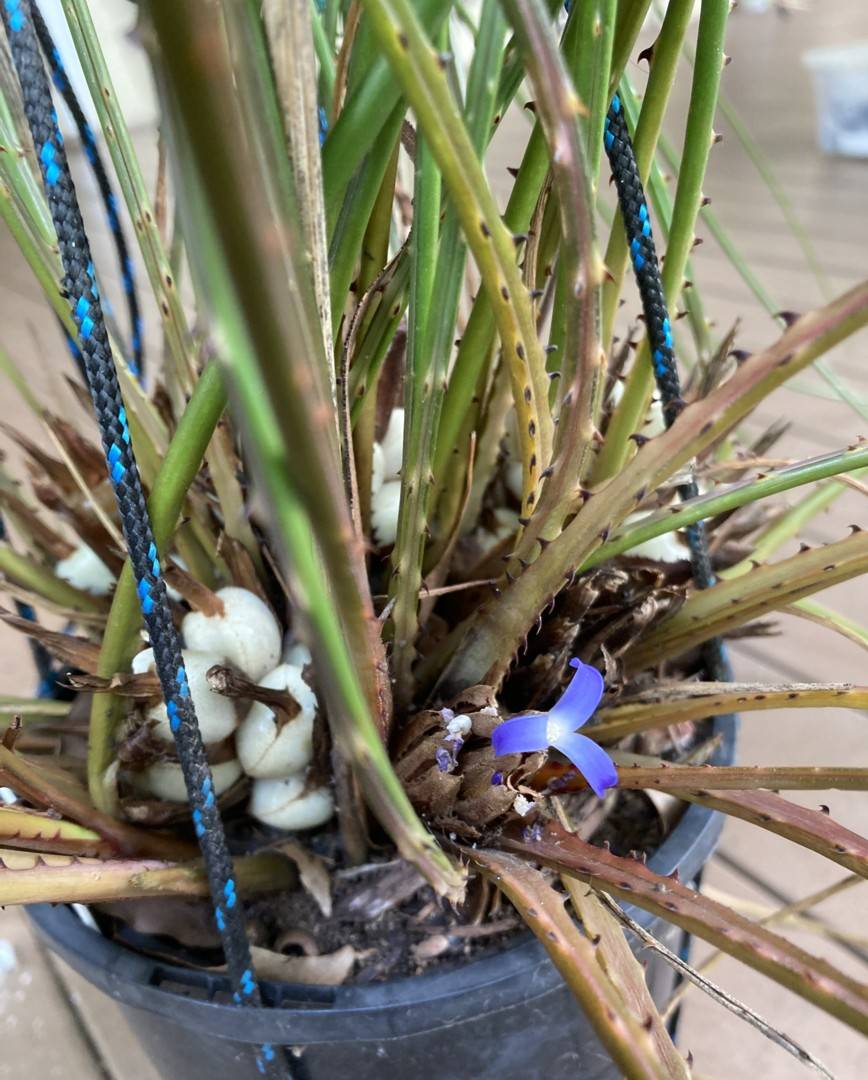
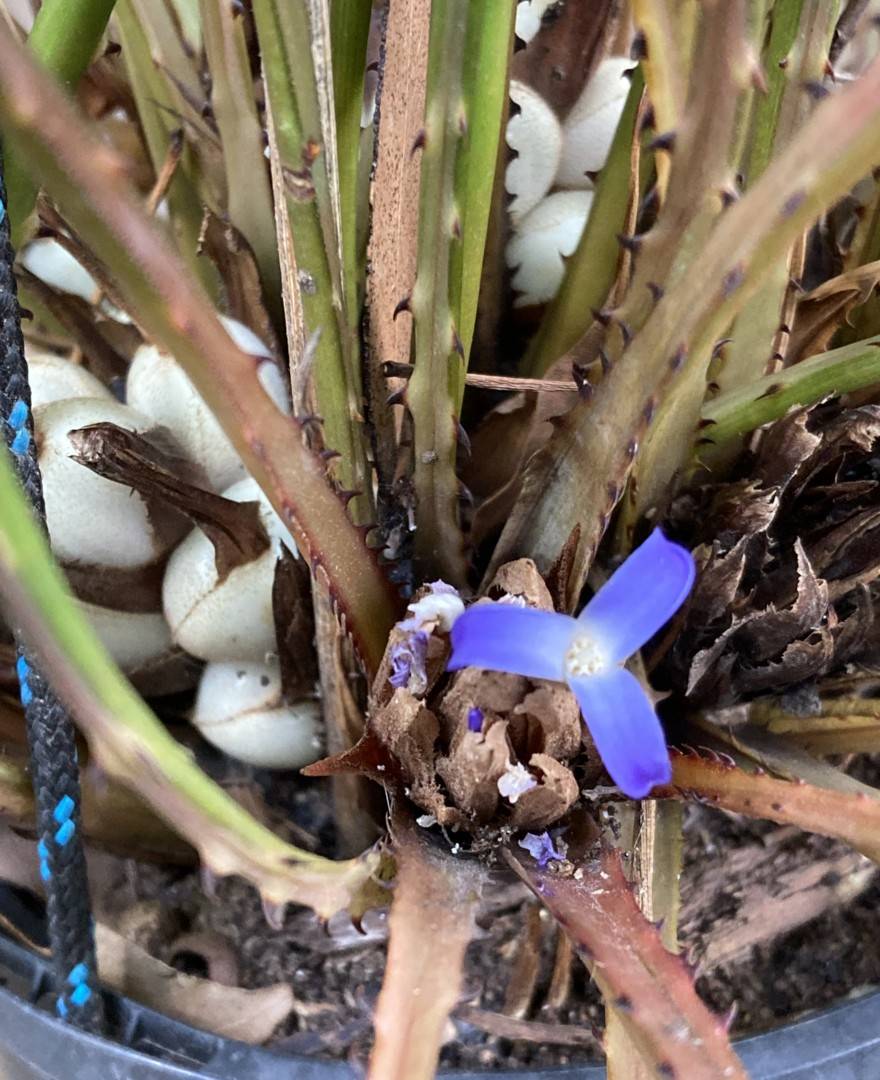
Aechmea pitcairnioides Mez, DC. Monogr. Phan. 9:258. 1896.
Desc from S&D
Leaves about 10, densely rosulate, to 4 dm long;
sheaths triangular, 25 mm wide, glabrous above at maturity, obscurely lepidote beneath with appressed brown scales;
blades involute-subulate, about 4 mm wide, long-acuminate, pungent, glabrous, the inner nearly entire, the outer laxly serrate with brown curved retrorse spines 2 mm long.
Scape lacking.
Inflorescence sunk in the center of the rosette, simple, few flowered, densely ellipsoid, ca 35 mm long, 20 mm in diameter.
Floral bracts broadly ovate, acute and pungent-apiculate, exceeding the flowers, serrulate with spines 1.5 mm long, castaneous when dry, appressed-brown -lepidote beneath but glabrous with age;
flowers sessile.
Sepals subsymmetric, narrowly lance-triangular, acuminate, mucronulate, 17 mm long, connate for 2 mm, strongly carinate, slightly lepidote becoming glabrous;
ovary ellipsoid, much compressed, 8 mm long, ferruginous-tomentulose; epigynous tube crateriform; placentae apical; ovules few, long-caudate.
Type. Blanchet s n (holotype, G; photo F 8482), Bahia, Brazil.
Distribution. Known from the type collection only.
Protologue
Aechmea pitcairnioides Mez, DC. Monogr. Phan. 9:258. 1896
81. Ae. pitcairnioides; inflorescentia inter folia nidulante, simplicissima spicata, compacte ellipsoidea; bracteis e late ovato acutis aciculoque valido terminali praeditis, margine spinis ad l.5 mm. longis auctis; floribus sessilibus; sepalis ad 2 mm. connatis, in aciculum desinentibus; ovario ferrgineo-tomentello; placentis loculis apice affixis; ovulis paucis, tenuiter caudatis.
Florifera haud ultra 0.2 m. alta, habitu Pitcairnia heterophylla. Folia ad 10 dense rosulata, e vagina depresse latissimeque triangulari, infime 25 mm. lata, intus adulta glabra dorso obscure peradpresseque brunneo-lepidota, apicem versus sensim angustata in laminam perangustam crasse subfiliformem, omnino stipitiformi-complicatam, persensim in aciculum terminalem brunneum desinentem, margine interioribus fere inermem exterioribus spinis validissimis (usque ad 2 mm. longis), brunneis, retro hamatis armatam, ad 0,4 m. longam, 4 mm. latam, glabram producta. Inflorescentia pauciflora, foliis perlonge superata, +/- 35 mm. longa, 20 mm. diam. metiens, bracteis in statu sicco castaneis, dorso lepidibus adpressis, fusco-brunneis obtectis demum glabratis. Flores petalis neglectis 28 mm. longi; sepalis 17 mm. longis, anguste triangulo-lanceolatis, perlonge acutis, quam maxime carinatis, dorso paullo lepidotis vel glabratis, subsymmetricis. Petala cum genitalibus ignota. Ovarium valde complanatum ellipticum, ad 8 mm. longum; tubo epigyno infundibuliformi. Fructus ignotus.
Brasilia centralis, prov. Bahia loco ignoto: Blanchet. (V. s. in herb. Candoll.)
Adding to the knowledge of the genus Acanthostachys KLOTZSCH with description of a second remarkable species – by Rauh & Barthlott in Trop. Subtrop. Plant. 39:5-34. 1982
On his autumn 1981 trip into the dry-areas of Brazil, Rauh visited Domingos Martins, Espirito Santo, and Roberto Kautsky, who in recent years has become known for new findings of numerous orchids – and Bromeliaceae. Several Bromeliads and orchids have been named after him. On a tree near a waterfall in his "garden", a quite large area, half nature-like forest, that extends upwards on the flanks of a mountain about 1,000 m high and with a variety of native plants, R. Kautsky discovered recently a remarkable Bromeliad with notably narrow, sedge-like leaves, glabrous, upper side narrow grooved, shiny, the edges strongly spined and an almost sessile inflorescence, deeply sunk into the leaf-rosette (abb. 2; abb. 4). Rauh took a piece of this plant with a young inflorescence and a berry, and in the Botanical garden at the University of Heidelberg developed first a shiny blue flower, that reminded at first strongly of a Neoregelia. We believed we had discovered a new, previously unnamed Bromeliad with the habit - a nestling inflorescence with blue flowers – which suggested it was close to the well known Acanthostachys strobilacea.
The Bromeliad specialist Dr. L. B. SMITH of the Smithsonian Institution, Washington, with whom we have had close cooperation for many years, alerted us to the fact that our plant had already been described by Mez (in DC. Monogr. Phaner. IX, 258, 1896, as Aechmea pitcairnioides Mez. It was discovered by the collector Blanchet in the State of Bahia and doesn't seem to have been found again since then, because L. B. SMITH writes in his Bromeliad Monograph, (1979, p.1908) “Known from the type collection only". The holotype, Blanchet, s. n., is in the herbarium of "Conservatoire et Jardin Botanique", Geneva.
The comparison of the same (abb 2, left), with our plant confirms the identity with the plant collected in Domingos Martins. However, it seems to be an extremely weak copy of the type,(abb. 2, left) because our plant is essentially more robust. Also, the type shows no fully developed flowers, and in the diagnosis no statements were made about the form of the flower or the petal colour.
Since our plant, whose uninterrupted development we could study from the germination up to the fruit - and seed-formation, now differs from all known Aechmea in essential characteristics, but shows a very strong and remarkable affinity to Acanthostachys strobilacea (Schultes fil.) Klotzsch, a single species in a monotypic genus. After discussion with L B Smith it was decided to take Aechmea pitcairnioides from the genus Aechmea and assign it to Acanthostachys as a second species of the genus. The genus Aechmea according to L. B. Smith is a genus with very heterogeneous species and needs urgent revision. L. B. SMITH (1979, p. 1768) wrote: "Aechmea includes some very discordant elements and is very likely of polyphyletic origin. Further research is likely to divide it with some parts becoming independent genera and others merging with genera at present considered distinct."
Before we substantiate our combination, there is hardly a Bromeliad collection without Acanthostachys strobilacea. It was described in 1830 by Schultes f. as Hohenbergia strobilacea, then transferred by Klotzsch (1841) into the genus Acanthostachys, at that time monotypic. Acanthostachys ananassoides Baker (in Handb. Bromel. 1889) remained known until L. B. Smith (Bot. Mus. Leafl. Harvard 1939) moved it to the genus Ananas, just as Acanthostachys exilis Bertoni, (in An. Cient. Parag., 1919), was treated as a synonym of Acanthostachys strobilacea.